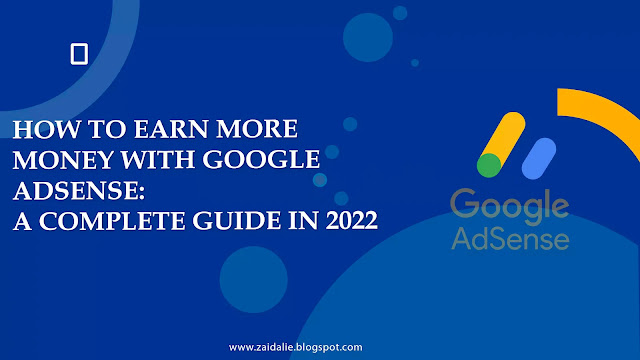
Do you want to profit from Google AdSense? If that's the case, you've come to the right place! We'll teach you everything you need to know about earning money with Google AdSense in 2022 in this article.
One of the most popular blog monetization methods for bloggers and webmasters to earn money online is through Google AdSense. The majority of website owners, particularly bloggers, anticipate having their AdSense accounts approved at the start of their careers.
In this article, I'll break down the process of earning money with zaid alie Google AdSense guide; it might help you get a better start on your AdSense money-making adventure. But, while Google AdSense is unquestionably the leader in PPC ad publishing, don't overlook other monetization methods such as affiliate marketing and freelancing.
However, even though it is a relatively simple concept, you must understand some specifics to succeed. We'll go over everything from understanding the basics of the advertising platform to getting started with ad campaigns.
To use this guide effectively, you must already have a website that is generating traffic through Google AdSense.
What is Google AdSense? And How Does it Perform?
Publishers and advertisers are connected through AdSense accounts. When publishers join their websites to the ad network, advertisers can bid to have their ads displayed on those sites. When a website visitor clicks or watches an ad, the publisher receives a percentage of the advertiser's ad bid.
CPC (cost per click) and CPM (cost per thousand impressions) are the most popular payment methods for Google Adsense, while CPC is the most prevalent because it pays more.
More Information Can be Found in this Google AdSense Video:
What Do You Need to Apply for an AdSense Account?
Google is strict about who they let into their advertising network. They want to keep the quality of their websites good and their ad network intact.
There are no Privacy Policies or Contact Pages:
If you want to make money online with AdSense, you'll need to take your website and blog seriously. Consider including a privacy policy, terms of service, about us, and contact us pages to demonstrate your website's professionalism.
1. Content of High-Quality:
Google is not looking for anything that has been copied, reproduced, or is already on the market. Quality material that is not yet available on the market is what Google is looking for. It must be grammatically correct, distinctive, and provide the user and the subject of what they are looking at with useful information.
2. Check Your Content:
While I've previously listed a few content strategies to consider, there's one more to consider, and that is the specialty. AdSense does not like the niches listed below, so if you have a site in one of these areas, I do not advocate using AdSense.
3. Address Details:
When applying for Adsense, make sure you put in your actual home address because Google will issue you a pin to verify your address.
The 5 Easiest Ways to Add Websites to Google AdSense:
Here are the five steps to integrating AdSense into your website. Let's get started.
Sign Up for AdSense:
Before you do anything else, you must first sign up for Google AdSense. You can skip step two if you've already been accepted and want to learn how to post the ads themselves.
Everyone else should begin by visiting the AdSense homepage.
Once there, click the Get Started button as follows:

You'll be led to a page similar to this one, where you'll have to fill in some information:
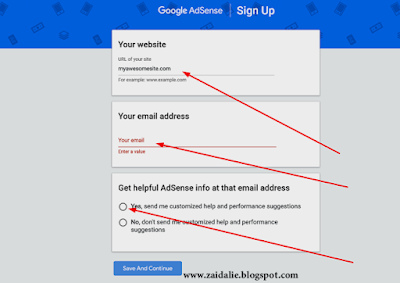
Fill in your site's URL, your primary email address, or one associated with your site, and click "Yes" when AdSense offers tailored assistance.
Once done, click Save And Continue once you've finished.
On the following page, you'll be asked to choose your nation and agree to some terms and conditions. Fill in the following information, then click "Create Account":
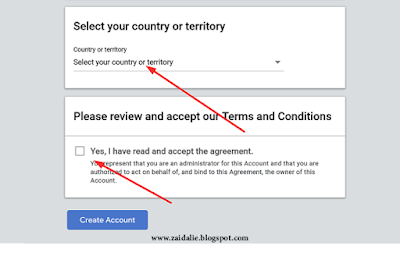
Your account will now be created.
Now we must fill in some basic payment information as well as your address. Fill in the blanks as needed, and then verify your phone number for added security:
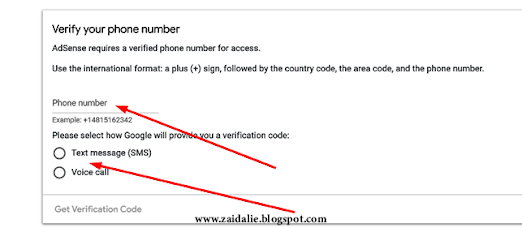
Remember that the format for the number is determined by your location and area.
After you've done that, you'll be given an AdSense code to insert into the HTML of your website.
This may appear difficult, but it's not as difficult as it appears—there are two ways to paste in the AdSense code.
To begin, you can use the Theme Editor in the Appearance section of the dashboard to add it to a WordPress site:

Be sure to paste the code between the <head > and </head > tags like so:

If you prefer to use a plugin, go to Plugins, Add New, and search for Insert Headers and Footers. Install the plugin and turn it on:
We're almost done.

All you have to do now is go to the Insert Headers and Footers plugin's settings and paste your code into the first box:
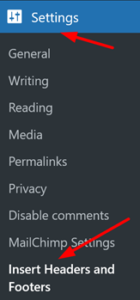
This is how the header box looks:
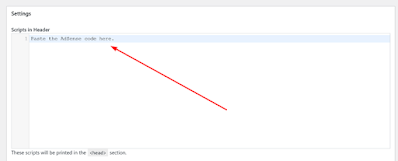
Return to the AdSense page after saving everything on WordPress. It will resemble the following:

After you've verified that you've pasted the code into your site, click Done.
Google will now examine your website and notify you when it has been approved. It could take anything from three days to three weeks to complete. You'll have to wait while Google evaluates your complete site for ad eligibility.
To improve your chances, leave the pasted code alone and make sure your site is appealing, well-organized, and features some high-quality content. Before submitting it to Google, you should finish the latter.
You'll also need to validate that your site has some daily traffic—people must be available to view the advertising.
Create the manual ad code as follows:
Let's pretend a few days or weeks have passed and you've received word from Google that you've been accepted for AdSense.
You were previously approved and now wish to advertise on your website.
In any case, we can immediately begin displaying advertisements on your website. The first method is to use manual advertisements.
To begin, go to the AdSense dashboard and look for the "Ads" section. Click here, then select "By ad unit" from the drop-down menu.
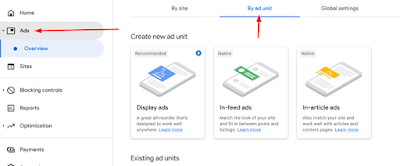
Select the ad type you wish to see—start with display advertisements.
You'll be directed to a page overlay where you can name your advertisement. This is only for internal use, so don't get too worked up about it:
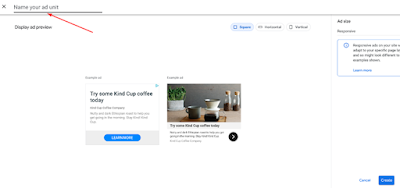
You must also select the ad's size and whether it should be responsive or fixed.
Click the "Create" button once you've made your selection.
You'll be given the HTML and AMP codes for the ad you selected, as follows:
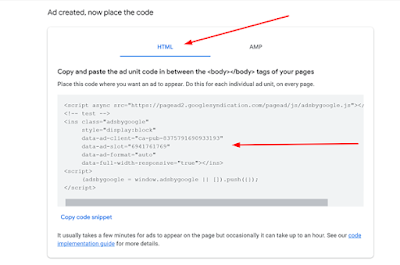
These codes can be copied for your mobile pages if your site is ready for AMP.
Let's concentrate on the HTML code for the time being.
Keep this handy because we'll need to copy it into WordPress.
In WordPress, Paste the Manual Ad Code:
Now you must decide where you want the ad to appear on your website. Ads in sidebars, for example, are common and can be achieved via widgets.
Navigate to Widgets under Appearance on your WordPress dashboard as follows:
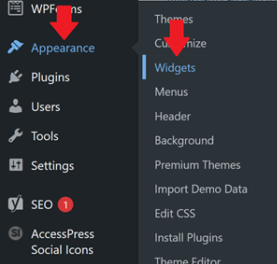
After that, click the Custom HTML widget and drag it to the location on your site where you want the ad to appear.
We're going to paste the manual ad code from before into this widget, as shown below:
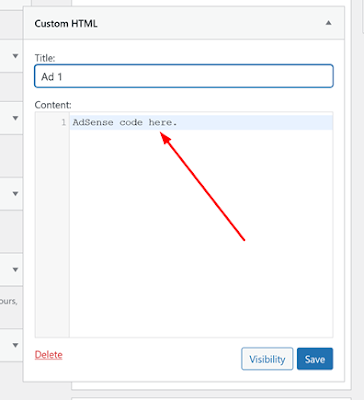
Copy the code and be sure to save it all by clicking the Save button below.
You should consider where people are most likely to look when deciding where to put them. Sidebars are a solid alternative, especially when combined with compelling written content.
Header advertising can be effective, but much depends on the style and content of your pages. Ads must be visible but not so invasive that they frustrate visitors.
Create the Auto Ad Code as Follows:
The second alternative is to employ automatic advertisements. The concept behind these ads is that you won't have to think about placements and that using them will save you time.
Because you won't be able to choose where the ads appear, the manual ad strategy may be preferable for some.
To use auto-ads, return to your AdSense dashboard, scroll down to "Ads" and select "By Site".
Something along these lines should be seen:

To generate your auto-ads code, simply click "Get code here". AdSense will now generate a code for you to use with auto-ads.
The following overlay will appear:

We want to click where it says "Copy code snippet".
How Long Does it take to have an AdSense Account Approved?
In most cases, your application will be reviewed within 48 hours. When your application is approved, advertisements will begin to appear on your blog, and you will begin to earn money.
Different Forms of AdSense Ads:
After you've been approved, you may begin running AdSense ads and earning money. It's a good idea to first learn about the many types of ad units. AdSense ad units are divided into five categories. Display, in-feed, in-article, matched content, and link advertising are among them.
Display Ads: These are standard display ad units that are responsive and fit on most screens. These advertisements can be used in practically any place. This form of advertisement can be responsive, according to the screen size of the device on which it is displayed. It's also compatible with AMP and may be customized to have fixed sizes (Accelerated Mobile Pages).

In-Feed Ads: Ads that appear in a feed, sidebar, or list. They flow more organically and give the consumer a better experience.
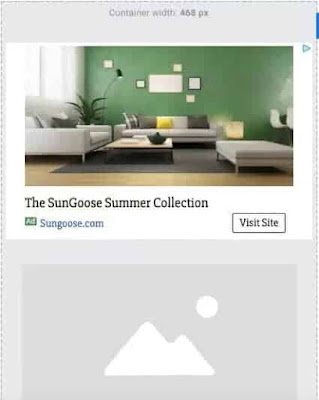
In-Article Ads: Native advertising that blends into an article's environment without interfering with the reading experience.
Matched Content Ads: Ads that suggest your website's content to users, increasing pageviews, user time on page, and the likelihood of them clicking on your ads.

Link Ads: Text link advertisements that might be responsive or fixed in size. It shows subjects that are relevant to the content of your page.
Creating Your First Ad Unit:
The advertisement space within a certain web page or mobile app where you display your ads is referred to as an ad unit. To do so, first, build an ad unit, then paste the code anywhere on your website where you want the ad to appear.

It's simple to create your first ad unit, and we recommend starting with display advertisements.
Ad units can be added to your website in a variety of ways. You may need to alter the website code to add your ad units, depending on the website platform you use. Some platforms include ad-supporting capabilities built-in, making it much easier to upload your ad unit code.
You can utilize numerous plugins, website widgets, and site-wide settings through themes to display your ads on platforms like WordPress. Here you can learn about the many methods for implementing ad code.
Easy AdSense Ads Optimization Techniques to Test:
You might look into ad optimization tactics now that you've gotten the hang of Google AdSense and are producing some ad revenue. Consider the following two extremely effective techniques:
Auto ads – AdSense auto ads are a simple method to increase ad revenue while letting Google handle the heavy lifting. Google employs machine learning to inject and optimize ad units into your website automatically, without overriding pre-existing ad units. With auto advertisements, you can also choose which type of ad you wish to utilize. We've put out a guide on how to use them here.
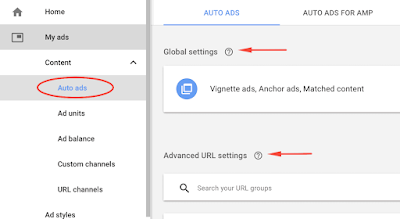
Sticky ad units—also known as anchor ads—are meant to stay in place when the user scrolls down the page. Ads used in this manner result in greater viewability and ad revenue for publishers. When using them via the internet, there are several limitations. Google AdSense. Find out how to implement sticky ads for AdSense here.
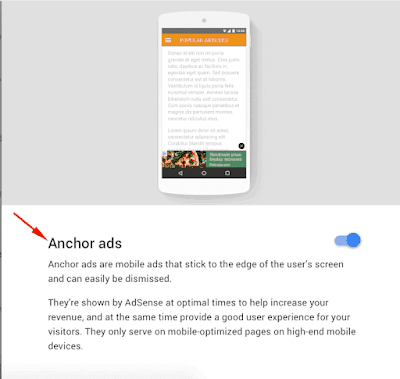
Protecting Your Account Against Invalid Traffic & What Not To Do:

Invalid traffic can lead to revenue clawbacks and AdSense bans for publishers. AdSense withholds a portion of ad profits due to invalid click activity using revenue clawbacks, which means you don't get paid for clicks on your advertisements.
Getting a clawback is terrible enough, but getting an invalid traffic ban is far worse. If your account is suspended, AdSense will stop serving advertisements on your website. Getting your account reinstated is likewise a difficult task.
More information on how Google defines invalid traffic can be found here. Publishers' clicking on their advertising (which they should never do), accidental clicks, click bots, and other types of invalid traffic are all examples of invalid traffic.
You don't want to waste time on invalid traffic because it can cost you money. Many AdSense publishers are completely unaware of this. That is why Monetize More has created the Traffic Cop service! Publishers are protected by Traffic Cop against the effects of illegitimate traffic, income clawbacks, and ad account bans.
Traffic Cop detects all types of illegitimate traffic while also preventing invalid traffic from seeing and clicking on your advertisements. We strongly advise you to take some steps to safeguard your business against unwanted traffic, and Traffic Cop is a highly effective and cost-effective option.
Conclusion:
Finally, you're ready to tackle the AdSense and ad monetization world! Do you need assistance with AdSense ad optimization and maximizing ad revenue?
Any website that isn't already offering a product or service should use AdSense. There are other different ad networks, but Google is the most well-known. There is no risk in trying out AdSense because it is free for publishers. When you're ready to set up AdSense, keep this guide handy as a reference.

Post a Comment
Please do not enter any spam link in the comment box.